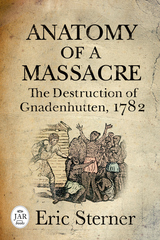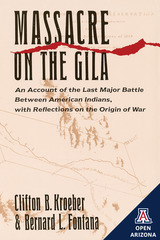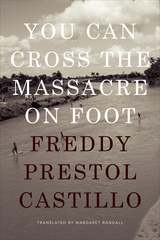4 books about Massacre

Anatomy of a Massacre
The Destruction of Gnadenhutten, 1782
Eric Sterner
Westholme Publishing, 2020
An Act of Unfathomable Cruelty that Presaged Post-Revolutionary America’s Treatment of Native Americans
On March 8, 1782, a group of western settlers killed nearly one hundred unarmed and peaceful Indians who had converted to Christianity under the tutelage of missionaries from the Church of the United Brethren. The murders were cold-blooded and heartless; roughly two-thirds of those executed were women and children. Its brutality stunned Benjamin Franklin in far-away France. He wrote: “the abominable Murders committed by some of the frontier People on the poor Moravian Indians, has given me infinite Pain and Vexation. The Dispensations of Providence in this World puzzle my weak Reason. I cannot comprehend why cruel Men should have been permitted thus to destroy their Fellow Creatures.” Since that maelstrom of violence struck the small Indian village of Gnadenhutten, history has treated the episode as a simple morality tale. While there were ample incidents of good and evil on March 8, that summation does not explain what brought murderers and victims together on the banks of the Muskingum River in today’s Ohio. It was actually the culmination of a series of events among different Indian tribes, the British, Congressional authorities at Pittsburgh, the Pennsylvania militia, and key individuals, all of which are lost in contemporary explanations of the massacre.
Anatomy of a Massacre: The Destruction of Gnadenhutten, 1782 fills that void by examining the political maneuvering among white settlers, Continental officials, British officers, western Indian tribes, missionaries, and the Indians practicing Christianity that culminated in the massacre. Uniquely, it follows the developing story from each perspective, using first-person accounts from each group to understand how they saw and experienced the changes on the American frontier. Along the way it profiles some of the key individuals responsible for the way the war unfolded. It is a fresh look at an often mentioned, but seldom understood, episode in the American Revolution.
On March 8, 1782, a group of western settlers killed nearly one hundred unarmed and peaceful Indians who had converted to Christianity under the tutelage of missionaries from the Church of the United Brethren. The murders were cold-blooded and heartless; roughly two-thirds of those executed were women and children. Its brutality stunned Benjamin Franklin in far-away France. He wrote: “the abominable Murders committed by some of the frontier People on the poor Moravian Indians, has given me infinite Pain and Vexation. The Dispensations of Providence in this World puzzle my weak Reason. I cannot comprehend why cruel Men should have been permitted thus to destroy their Fellow Creatures.” Since that maelstrom of violence struck the small Indian village of Gnadenhutten, history has treated the episode as a simple morality tale. While there were ample incidents of good and evil on March 8, that summation does not explain what brought murderers and victims together on the banks of the Muskingum River in today’s Ohio. It was actually the culmination of a series of events among different Indian tribes, the British, Congressional authorities at Pittsburgh, the Pennsylvania militia, and key individuals, all of which are lost in contemporary explanations of the massacre.
Anatomy of a Massacre: The Destruction of Gnadenhutten, 1782 fills that void by examining the political maneuvering among white settlers, Continental officials, British officers, western Indian tribes, missionaries, and the Indians practicing Christianity that culminated in the massacre. Uniquely, it follows the developing story from each perspective, using first-person accounts from each group to understand how they saw and experienced the changes on the American frontier. Along the way it profiles some of the key individuals responsible for the way the war unfolded. It is a fresh look at an often mentioned, but seldom understood, episode in the American Revolution.
[more]

Massacre of the Innocents
Bin Ramke
University of Iowa Press, 1995
Massacre of the Innocents is the work of a secular poet who admires the basic texts—the angry qualities of fairytales equally along with the humorous virtues of sacred scriptures. Speaking with the voice of mature accomplishments, Ramke's poems do not struggle for their words but release them from a near-inexhaustible source.
As Ramke has said, “Poems are like children and have minds and manners of their own, luckily beyond the control of parents and poets.” These poems talk back—and they talk to each other. By stripping away the distractions of received meaning from the words he uses, Ramke makes necessary connections between reader and poem that can freshen meaning—make it new—as is often claimed for poetry but seldom achieved so well as in his work.
[more]

Massacre on the Gila
An Account of the Last Major Battle Between American Indians, with Reflections on the Origin of War
Clifton B. Kroeber
University of Arizona Press, 1986
"The careful reconstruction of the September 1, 1857 battle at Maricopa Wells, combined with the thorough and well-written summary of available information on patterns of regional conflict, makes this book a valuable contribution to the ethnohistory of the middle Gila and Lower Colorado River area." —American Anthropologist
"Rarely do the skills of historians and anthropologists mesh so admirably." —Western Historical Quarterly
"Kroeber and Fontana are meticulous professionals. Their study of this neglected slice of Southwestern history deserves applause." —Evan S. Connell, Los Angeles Times Book Review
"A rich feast for the curious and theorist alike." —Pacific Historical Review
"Kroeber and Fontana describe a little-known event, provide an effective analysis of the cultures of Indian groups in southwestern Arizona, and attempt to understand the broader causes of warfare. The result is an interesting and provocative study." —Journal of American History
"Rarely do the skills of historians and anthropologists mesh so admirably." —Western Historical Quarterly
"Kroeber and Fontana are meticulous professionals. Their study of this neglected slice of Southwestern history deserves applause." —Evan S. Connell, Los Angeles Times Book Review
"A rich feast for the curious and theorist alike." —Pacific Historical Review
"Kroeber and Fontana describe a little-known event, provide an effective analysis of the cultures of Indian groups in southwestern Arizona, and attempt to understand the broader causes of warfare. The result is an interesting and provocative study." —Journal of American History
[more]

You Can Cross the Massacre on Foot
Freddy Prestol Castillo
Duke University Press, 2019
In 1937 tens of thousands of Haitians living in the Dominican Republic were slaughtered by Dominican troops wielding machetes and knives. Dominican writer and lawyer Freddy Prestol Castillo worked on the Haiti-Dominican Republic border during the massacre, known as “The Cutting,” and documented the atrocities in real time in You Can Cross the Massacre on Foot. Written in 1937, published in Spanish in 1973, and appearing here in English for the first time, Prestol Castillo's novel is one of the few works that details the massacre's scale and scope. Conveying the horror of witnessing such inhumane violence firsthand, it is both an attempt to come to terms with personal and collective guilt and a search to understand how people can be driven to indiscriminately kill their neighbors.
[more]
READERS
Browse our collection.
PUBLISHERS
See BiblioVault's publisher services.
STUDENT SERVICES
Files for college accessibility offices.
UChicago Accessibility Resources
home | accessibility | search | about | contact us
BiblioVault ® 2001 - 2024
The University of Chicago Press









